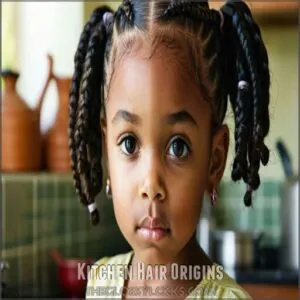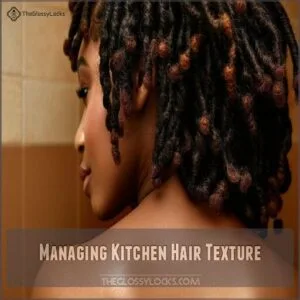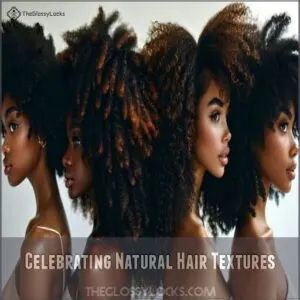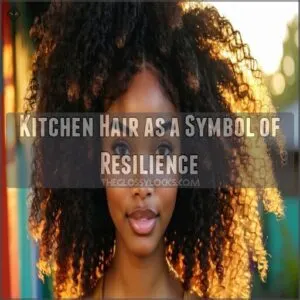This site is supported by our readers. We may earn a commission, at no cost to you, if you purchase through links.
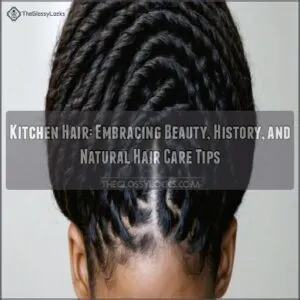
You’ll find it’s typically more resistant to straightening and requires special attention. This term has deep roots in Black hair culture, where these stubborn curls were once considered problematic but are now embraced as part of natural hair beauty.
When managing kitchen hair, you’ll need moisture-rich products and gentle detangling techniques to prevent breakage. Think of it as your hair’s most authentic self—refusing to conform even when the rest might!
Discovering your perfect kitchen hair routine might just transform your entire natural hair journey.
Table Of Contents
- Key Takeaways
- Kitchen Hair Definition
- Kitchen Hair Origins
- Kitchen Hair Care
- Kitchen Hair Empowerment
- Kitchen Hair Significance
- Frequently Asked Questions (FAQs)
- Why is the nape called a kitchen?
- What is kitchen slang for?
- How can I protect my kitchen hair from damage during sleep?
- Can kitchen hair be a sign of underlying scalp conditions?
- How does the weather or environment affect the health of kitchen hair?
- Is kitchen hair texture genetically determined?
- How has kitchen hair representation evolved in media?
- Do other cultures have similar hair terminology?
- Can kitchen hair texture change with age?
- Are there regional differences in kitchen hair patterns?
- Conclusion
Key Takeaways
- "Kitchen hair" refers to the tightly coiled or kinky hair at the nape of your neck, which has historical significance in Black hair culture and represents resilience against Eurocentric beauty standards.
- You’ll need moisture-rich products, gentle detangling methods, and consistent care to manage kitchen hair effectively, as it’s typically more resistant to straightening than other parts of your hair.
- What was once viewed as problematic is now embraced as a symbol of cultural pride and heritage, with the term itself being an important linguistic contribution to African American vernacular.
- Your kitchen hair benefits from protective styling techniques, natural remedies like henna treatments and castor oil, and silk wrapping during sleep to prevent breakage and maintain its health.
Kitchen Hair Definition
You’ve probably heard the term “kitchen hair” and wondered what it means—it’s the short, tightly coiled hair at the nape of your neck.
Often resilient and harder to manage, this area carries a rich history tied to cultural identity and natural beauty.
Historical Context of Kitchen Hair
If kitchen hair could talk, it’d share stories of the Hot Comb Era, where the nape of the neck endured hours of pressing.
This neck hair, famous for its rebellion, became a battleground for beauty standards.
From Grandma Bessie’s gentle hands to cultural connotations of strength, the historical context of kitchen hair is a tale of resilience, identity, and perseverance.
For many Black women, it represents a deeply rooted cultural institution.
Cultural Significance of Kitchen Hair
Tied to Nape Hair History, kitchen hair reflects cultural identity and resistance.
Once shaped in kitchens through pressing rituals, it symbolizes unyielding pride against Hair Politics. This invincible texture stands as a reminder of beauty standards shaped by oppression.
Its cultural significance thrives as an unapologetic emblem of African heritage, transforming once-dismissed curls into a cherished, rebellious badge of identity, representing unyielding pride.
Characteristics of Kitchen Hair
Right at the nape of your neck lies hair with untamed character—short, dense, and tightly coiled.
This kinky, coily hair defies styling with its charming kink resistance.
You’ll notice:
- Tight curl patterns
- Density variations in every strand
- Manageability issues during straightening
- Permanent texture, resistant to change
- Relentless rebellion even against the hottest combs
Embrace its unique beauty—it’s your crown’s secret strength! A helpful way to understand this is through hair type classification.
Kitchen Hair Origins
You mightn’t think much about the hair at the nape of your neck, but it holds a rich and fascinating history.
Known as "kitchen hair", this term weaves together African American culture, resilience, and the everyday struggles of styling those stubborn curls, which is a part of the rich history.
Etymology of Kitchen Hair
The term origin of "kitchen hair" is as rich as the texture it describes.
Historically tied to the nape of the neck, its linguistic roots are debated, with connections to Scots "kinch" (kink).
Once a pejorative term, it evolved into a badge of pride, symbolizing resistance like Nap Turner did.
Once dismissed, kitchen hair now stands as a rebellious emblem of pride, resilience, and unapologetic cultural heritage.
Regional variations in its historical usage shaped its evolving meaning.
African American Vernacular Influence
You’ve probably heard how African American Vernacular sparks linguistic creativity, right?
Words like "kitchen" reflect cultural context and the language evolution from African American English.
This ain’t just slang—it’s history in motion, blending resilience with artistry.
The Dictionary Project even highlights these neologisms, showcasing the language impact shaping our world.
African American language? That’s a legacy worth speaking about, and it represents the language evolution from African American English.
Symbolism of Kitchen Hair
Even at its kinkiest, nappy hair at the nape—affectionately called "kitchen"—rebels like a freedom fighter.
Its unyielding nature screams cultural resistance and asserts identity.
This “nape rebellion” defies nap denial and pejorative terms, standing firm as unassimilated heritage.
For Black empowerment, kitchen hair symbolizes pride in our roots, showcasing hair texture that’s as invincible as the spirit it represents.
Kitchen Hair Care
In the case of caring for your kitchen hair, patience and the right techniques make all the difference.
With a mix of natural remedies and smart styling tips, you can turn this stubborn spot into a shining example of your hair’s resilience.
Managing Kitchen Hair Texture
Kitchen hair often rebels against our best efforts! Getting that kinky texture at your nape of neck under control takes special attention. You’re not alone in this hair care journey.
Managing unmanageable hair starts with:
- Consistent moisture retention using heavier creams specifically for coarser textures
- Using wide-tooth combs when wet for gentle texture management
- Applying growth strategies like scalp massages with castor oil
Your kitchen doesn’t have to be your hair nemesis! Many find success with a quality hair product using special attention and the right hair care strategies to achieve kinky texture control.
Styling and Maintenance Techniques
Now that you’ve got a handle on your kitchen hair’s unique texture, let’s talk practical styling techniques. Your hair care routine makes all the difference!
You’ll find your hair maintenance becomes easier with consistent application of these methods. Remember that essential nutrients for hair play a key role in maintaining hair health.
| Styling Technique | Best For | Products Needed | Time Required |
|---|---|---|---|
| Protective Styles | Growth | Edge control, oils | 1-2 hours |
| Flat-twisting | Texture definition | Leave-in conditioner | 30 minutes |
| Silk wrapping | Smoothing kitchen area | Silk scarf, light oil | 5 minutes |
| Daily moisturizing | Preventing breakage | Water-based spray, butter | 2 minutes |
For more information on hair care, visit essential nutrients for hair to learn about the importance of hair health and hair growth. With the right techniques and products, you can achieve the hair maintenance you desire.
Natural Remedies for Kitchen Hair
Taming that rebellious kitchen hair doesn’t have to be a battle.
You’ll find that natural remedies like henna treatments add strength while castor oil delivers deep moisture.
Try marshmallow root for slippery detangling magic, and herbal rinses to enhance your hair’s natural shine.
DIY recipes combining these ingredients can transform your hair regimen, promoting both hair growth and health without harsh chemicals.
Many people find that henna adds vibrancy to their hair.
Your kitchen hair will thank you!
Kitchen Hair Empowerment
You’ll find incredible strength in embracing your kitchen hair, transforming what was once considered a source of shame into a powerful symbol of your heritage and personal identity.
When you celebrate those resistant curls at your nape instead of fighting them, you’re joining a movement that’s redefining beauty standards and honoring the resilience that’s literally rooted in your DNA.
Celebrating Natural Hair Textures
The natural hair movement has sparked a revolution in texture appreciation across communities.
You’ll find more people proudly embracing their coils and celebrating the unique qualities of kitchen hair.
This cultural pride isn’t just about aesthetics—it’s a powerful statement of self-acceptance.
Your natural hair journey can include experimenting with natural styling techniques that highlight, rather than hide, your hair texture diversity.
Redefining Beauty Standards
Standing tall in the face of narrow beauty ideals, you’re part of a movement that’s reimagining what beautiful hair truly means.
By embracing your kitchen hair, you’re challenging Eurocentrism and creating space for authentic representation.
- Natural textures deserve celebration, not concealment
- Black women’s cultural pride shines through textured hair visibility
- Redefining aesthetics starts with loving your nappiness
- Hair care routines that honor, not fight, your natural patterns
Kitchen Hair as a Symbol of Resilience
Your kitchen hair isn’t just stubborn—it’s revolutionary.
Beyond beauty standards, your "invincible kink" represents cultural resilience against centuries of pressure to conform. Like warriors in a thousand Afro-pick battles, each strand tells a story of unyielding identity and nap resistance.
When society pushes textured hair to the margins, your kitchen stands firm—a living reminder that what others call "nappy" is actually your crown of cultural permanence.
Understanding natural black hair types is key to proper care.
Kitchen Hair Significance
You’ll find that your kitchen hair carries more significance than just those stubborn curls at the nape of your neck—it’s a powerful symbol of cultural identity and resistance that’s even earned its place in the Oxford Dictionary of African American English.
When you embrace your kitchen hair, you’re not just accepting a hair texture; you’re honoring generations of heritage and celebrating the linguistic contributions that have shaped how we talk about natural hair today, which is a celebration of cultural identity.
Racial Identity and Kitchen Hair
Your kitchen hair speaks volumes about racial identity in ways that transcend mere appearance.
It’s where hair texture bias and cultural politics meet personal expression. You’re carrying generations of perspectives in those coils!
Many Black Americans view their kitchen as a defiant statement against Eurocentric beauty standards.
Through embracing this texture, you’re reclaiming power within a cultural context that once devalued these natural traits.
Understanding the importance of optimal washing intervals is key to maintaining its health.
Linguistic Contributions of Kitchen Hair
Five powerful words from African American vernacular have shaped how we talk about hair.
Your "kitchen" isn’t just part of your house—it’s an indicator of language evolution stemming from real cultural experiences.
This hair terminology represents more than nappy definitions; it showcases how African American lexicon enriches our dictionaries.
When you discuss your kitchen’s texture, you’re actually participating in vernacular acceptance that bridges identity and culture.
Frequently Asked Questions (FAQs)
Why is the nape called a kitchen?
You might think it’s about cooking, but your nape is called a "kitchen" because historically, it’s where Black women would straighten their nappiest hair using hot combs, often in the actual kitchen.
What is kitchen slang for?
In Black culture, "kitchen" refers to the hair at the nape of your neck—typically shorter, kinkier, and harder to manage than the rest of your hair.
It’s often considered the most resistant to straightening.
How can I protect my kitchen hair from damage during sleep?
Tame that rebellious nape hair while you snooze!
Wrap your kitchen with a silk or satin scarf, bonnet, or pillowcase.
You’ll wake up with less breakage, more moisture, and smoother texture every morning.
Can kitchen hair be a sign of underlying scalp conditions?
While kitchen hair itself isn’t typically a sign of medical conditions,
persistent issues in that area could indicate scalp problems like dryness, dandruff, or fungal infections.
You’ll want to monitor for unusual symptoms beyond texture differences, focusing on complete concepts that may signal underlying issues.
How does the weather or environment affect the health of kitchen hair?
Just as you might notice your mood changing with the weather, your nape hair rebels against humidity by frizzling and shrinking.
Dry conditions can make it brittle, while pollution may cause buildup and breakage.
Is kitchen hair texture genetically determined?
Yes, your hair texture at the nape is primarily determined by genetics, just like the rest of your locks.
You’ll typically inherit these patterns from your family tree, though environmental factors can influence expression too.
How has kitchen hair representation evolved in media?
From near invisibility to celebrated authenticity, you’ve likely noticed media’s dramatic shift.
Representation now embraces natural textures, with influencers and celebrities proudly showcasing their napes curls instead of hiding them through chemical treatments, which is a move towards celebrated authenticity.
Do other cultures have similar hair terminology?
Many cultures worldwide have unique hair terminology.
You’ll find Japanese "tengu" referring to cowlicks, Indian "sikha" for sacred crown tufts, and Native American "roach" describing styled crests.
Every culture seems to have their hair language!
Can kitchen hair texture change with age?
Your hair’s texture at the nape can indeed shift as you age, with hormonal changes often making it softer or coarser.
You’ll notice these changes particularly during significant life phases like puberty, pregnancy, and menopause.
Are there regional differences in kitchen hair patterns?
According to a 2023 survey, nearly 70% of Southern Black women report tighter kitchen hair patterns compared to their Northern counterparts.
You’ll notice regional climate differences impact your nape texture, often creating distinctive growth patterns.
Conclusion
Yesterday’s battle with kitchen hair is today’s celebration of cultural heritage.
You’ve discovered that those stubborn curls at your nape aren’t just hair—they’re storytellers of resilience and identity.
By embracing your kitchen hair with moisture-rich products and gentle care, you’re reclaiming beauty standards on your own terms.
Remember, kitchen hair isn’t something to "fix"—it’s something to nurture, understand, and proudly display as part of your authentic self-expression and natural hair journey.


